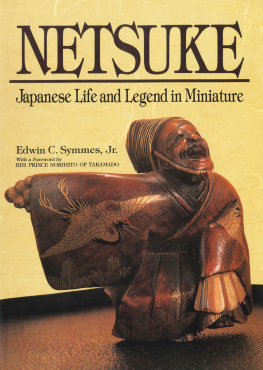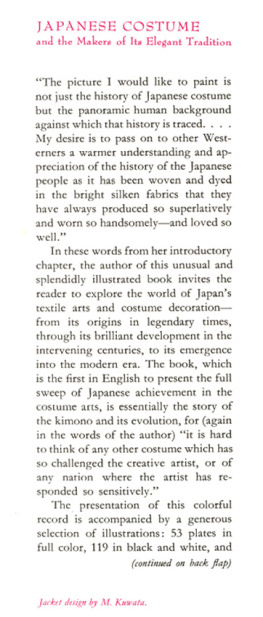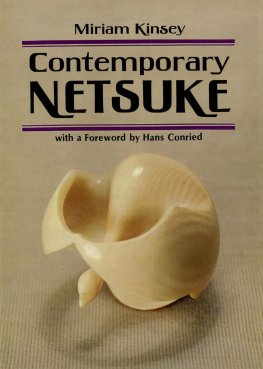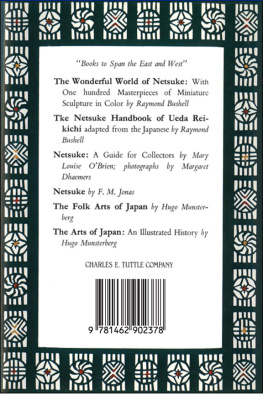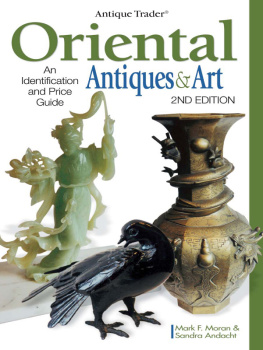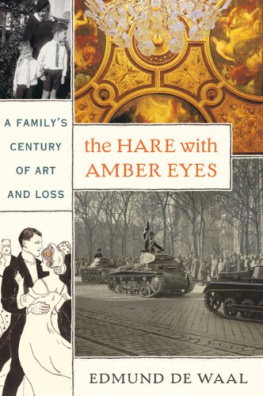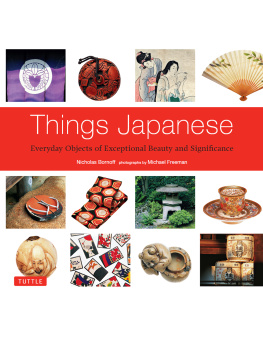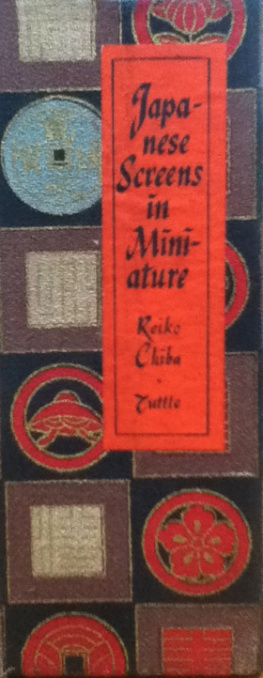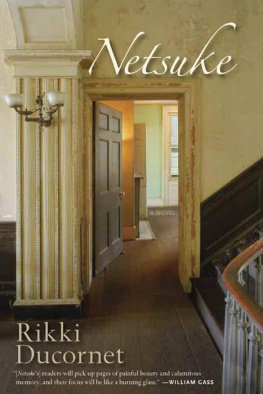Selected Bibliography
Allen, Maude Rex. Japanese Art Motives. Chicago: A.C. McClurg, 1917.
Arakawa, Hirokazu (Tokyo National Museum). The Go Collection of Netsuke. Tokyo and New York: Kodansha International.
Bush, Lewis. Japanalia, Past and Present. In two volumes. Tokyo: The Japan Times, 1967.
Bushell, Raymond. Collector's Netsuke. New York and Tokyo: John Weatherhill, 1975.
_____. An Introduction to Netsuke. Tokyo and Rutland, Vermont: Charles E. Tuttle, 1971.
_____. The Wonderful World of Netsuke. Tokyo and Rutland, Vermont: Charles E. Tuttle, 1964.
Davey, Neil K. Netsuke. London: Faber & Faber, 1974, in association with Sotheby, Parke Bernet Publications.
Davis, F. Hedland. Myths and Legends of Japan. London: Harrop, 1912.
Dorson, Richard M. Folk Legends of Japan. Tokyo and Rutland, Vermont: Charles E. Tuttle, 1962.
Edmunds, Will H. Pointers and Clues to the Subjects of Chinese and Japanese Art. London: Sampson Low, Marston, 1934.
Forman, Werner: Japanese Netsuke. London: Spring Books, 1960.
Hurtig, Bernard, compiler: Masterpieces of Netsuke Art: One Thousand Favorites of Leading Collectors. New York and Tokyo: John Weatherhill, 1973 (published for the International Netsuke Collectors' Society).
_____. Rare Netsuke Masterpieces. Honolulu: Orientwest, n.d.
_____. Journal of The International Netsuke Collectors Society. Honolulu: International Netsuke Collectors Society, 1977-85.
Jahss, Melvin, and Jahss, Betty. Inro and Other Miniature Forms of Japanese Lacquer Art. Tokyo and Rutland, Vermont: Charles E. Tuttle, 1971.
Japan Netsuke Carvers' Association. Exhibition of Contemporary Netsuke 1982; 1983; 1984; 1985; 1986; 1987; 1988. Tokyo: Japan Netsuke Carvers' Association.
Japan Travel Bureau. Festivals of Japan. Tokyo: Japan Travel Bureau, 1987.
Joly, Henri L. Legend in Japanese Art. Tokyo and Rutland, Vermont: Charles E. Tuttle, 1967.
Joya, Mock. Quaint Customs &. Manners of Japan. In three volumes. Tokyo: Tokyo News Service, 1953.
Jonas, F. M. Netsuke. London: Kegan Paul, Trench, Trubman, 1928; reprinted by Tokyo and Rutland, Vermont: Charles E. Tuttle, 1960.
Kinsey, Miriam. Contemporary Netsuke. Tokyo and Rutland, Vermont: Charles E. Tuttle, 1977.
_____. Living Masters of Netsuke. Tokyo and New York: Kodansha International, 1983.
Lazarnick, George. The Signature Book of Netsuke, Inro and Ojime Artists in Photographs. Honolulu: Reed Publishers, 1976.
London Netsuke Committee. Contrasting Styles. London: Sawers, 1980.
Mitford, A.B. (Lord Redesdale). Tales of Old Japan. Tokyo and Rutland, Vermont: Charles E. Turtle, 1966.
Moss, Paul. Japanese Netsuke: Serious Art. London: Sydney L. Moss, 1989.
Naito, Hiroshi. Legends of Japan. Tokyo and Rutland, Vermont: Charles E. Turtle, 1972.
Netsuke Kenkyukai Society. Netsuke Kenkyukai Study Journal. Torrance, CA: Netsuke Kenkyukai Society.
O'Brien, Mary Louise. Netsuke: A guide for Collectors. Tokyo and Rutland, Vermont: Charles E. Turtle, 1965.
Reikichi, Ueda. The Netsuke Handbook of Ueda Reikichi. Adapted from the Japanese by Raymond Bushell. Tokyo and Rutland, Vermont: Charles E. Turtle, 1961.
Roberts, Laurance P. A Dictionary of Japanese Artists. New York and Tokyo: John Weatherhill, 1976.
Ryerson, Egerton. The Netsuke of Japan. London: G. Bell and Sons, 1958.
Sakade, Florence. Little One-Inch and Other Japanese Children's Favorite Stories. Tokyo and Rutland, Vermont: Charles E. Turtle, 1958.
Shimizu, Yoshiaki. Japan: The Shaping of Daimyo Culture, 1185-1868. Washington, D.C.: National Gallery of Art, 1988.
Sunatomo, Seiichiro. Exhibition of Fine Contemporary Netsuke. Tokyo: Sunatomo Co., 1989.
Symmes, Edwin and Symmes, Rhena. Native Treasures: American Bonsai Photo Book. Atlanta, Georgia: E. C. Symmes Associates, 1973.
Takama, Shinji. The World of Bamboo. South San Francisco: Heian, 1981.
Tokyo National Museum. Special Exhibition, Art of the Muromachi Period. Tokyo: Tokyo National Museum, 1989.
Tsukamoto, Takumi. Folk Legends of Aso. Kumamoto: Takumi Tsukamoto, 1985.
Tollner, Madeline R. Netsuke. San Francisco: Academy Phototype Service, 1954. Second printing, San Francisco: Fearon Publishers, 1960.
Williams, C.A.S. Chinese Symbolism and Art Motifs. Shanghai: Kelly and Walsh, 1941; reprinted Tokyo and Rutland, Vermont: Charles E. Turtle, 1965.
Yamaguchi, H.S.K. We Japanese. Hakone: Fujiya Hotel, 1949.
Yanagira, Kunio. Japanese Folk Tales. Translated by Fanny Hagin Mayer. Tokyo: Tokyo News Service, 1954; second edition, 1958.
Yasuda, Yuri: Old Tales of Japan. Tokyo and Rutland, Vermont: Charles E. Turtle, 1953.
Notes on Netsuke Carving
Netsuke have been created from almost every imaginable material. As mentioned earlier, objects such as roots, stones, and sea shells have been utilized successfully. In those, the only "creative" aspect was to find something attractive and tie the cord to it. Some netsuke are made from lacquer, a process of building up the form with repeated coats of lacquer paint (see Plate .
The majority were created by carving. And what exquisite carvings they are! It is fairly safe to say that there is no suitable material that has not been carved to create netsuke. Although ivory and boxwood have been two traditional favorite materials, everything from mammoth tusk to pine has also been used. In fact, many netsuke use more than one material. Some use the additional material naturally such as an ebony figure of a South Seas diver clutching a natural piece of coral. A frequently used second material is horn, which is often inset to give the eyes a translucent glow that heightens the liveliness of the carving.
With many nations honoring the ban on international trade in ivory, the netsuke carvers have been seeking new and/or different materials to work in. They have been searching for material that is as strong as ivory and will hold the crispness of detail in the carvings that ivory is noted for. In looking for a material that is acceptable to the conservationists, even synthetic materials have been used in experiments. Fortunately, collectors of fine netsuke are interested in the art form, not merely ivory carvings. The result has been an increase in the variety of materials that are currently used by netsuke carvers. Two examples of new materials for netsuke carving are mammoth tusk (Plate ). Other materials include pink ivory wood from New Zealand, mountain mahogany from the United States, and fossilized walrus tusk. These natural materials and many others now provide a richer palette from which the netsuke carver can choose to create a particular effect. The master carver will always choose to imbue his ideas, spirit, and designs into the rich, compelling beauty of natural materials.
Contrary to the original fear that the ivory embargo would eliminate netsuke carving, it has infused a new vigor into the carvers as they learn to work with and master the variety of materials available to them today. And this in turn gives the netsuke collector a greater range of beautiful objects from which to choose.

Katsutoshi Saito carves under the artist's name of Bishu. When my editor, Stephen Comee, and I visited him at his home/studio on the outskirts of Tokyo, he was happy to welcome us into his carving studio. Bishu is the president of the International Netsuke Carvers' Association, and was instrumental in getting members to change the former name of the Japan Netsuke Carvers' Association to reflect the international interest in netsuke and netsuke carving. One might think that he is a radical for encouraging non-Japanese to carve netsuke. However, as we found on our visit, he is a charming, gracious host who freely answered all of our questions and posed for what must have seemed like endless photographs.

